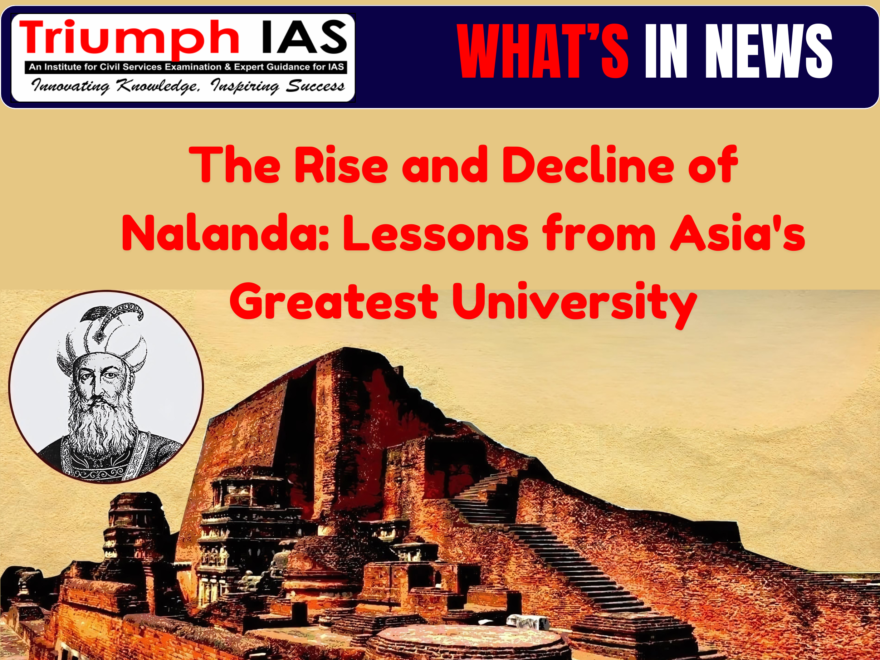The Rise and Decline of Nalanda: Lessons from Asia’s Greatest University
Why in News
The Prime Minister of India recently officially opened the Nalanda University campus. Situated in Rajgir, Bihar, the campus spans 455 acres and is just 12 km from the remains of the historic Buddhist monastery with the same name.
Nalanda, the Buddhist mega-monastery in present-day Bihar, was perhaps the single most famous center of higher learning in all of Asia. It attracted students from Java, Tibet, China, and possibly even Mongolia and Korea. This renowned Buddhist mahavihara (great monastery) operated from 427 CE until the 13th century, playing a vital role in promoting the patronage of arts and academics during the “Golden Age of India.”
Historical of Nalanda University
- Nalanda University was established by Gupta Emperor Kumaragupta (Shakraditya) in 427 CE during the early 5th century in modern Bihar.
- It thrived for 600 years until the 12th century.
- It gained popularity during the time of Harshavardhana and the Palas monarchs.
- Chinese scholar Xuan Zang (Hiuen Tsang) studied at Nalanda during King Harshavardhana’s reign and took many scriptures back to China.
- Around 670 AD, another Chinese pilgrim I-Tsing visited Nalanda and noted that it had 2,000 students supported by money from 200 villages.
- The university attracted students from China, Mongolia, Tibet, Korea, and other Asian countries.
- Archaeological evidence suggests connections with the Indonesian Shailendra dynasty.
- Spiritual leaders like Lord Buddha and Lord Mahavira meditated in the region, contributing to its positive energy.
- Scholars like Nagarjuna, Aryabhatta, and Dharmakirti added to the scholarly traditions of ancient Nalanda.
- The university was destroyed in 1193 by Bakhtiyar Khilji, a general of the Turkish ruler Qutbuddin Aibak.
- It was rediscovered in 1812 by Scottish surveyor Francis Buchanan-Hamilton and later confirmed as the ancient university by Sir Alexander Cunningham in 1861.
The Grandeur of Nalanda
Attacks on Nalanda University
- The first assault on Nalanda Mahavihara took place between 455-470 AD under the rule of Emperor Samudragupta of the Gupta Empire.
-
- The assailants were the Hunas, a Central Asian tribal group, primarily motivated by the desire to plunder the university’s valuable resources.
- Emperor Skanda Gupta subsequently re-established the university, and it was during his reign that the renowned Nalanda library was established.
The second attack on Nalanda Mahavihara occurred in the early 7th century, orchestrated by the Goudas emperors of Bengal due to political tensions with Emperor Harshavardhana of Kannauj. Despite the devastation, the university was rebuilt by Harshavardhana, enabling Nalanda to continue its mission of disseminating global knowledge.
The Decline of Nalanda
While Nalanda’s wealth made it a target for Turkic raiders in the 12th century, the fact is that the monastery was already in decline by that time. By the 11th century, Nalanda and other Buddhist monasteries were losing importance in eastern India, as Indonesian and Javanese masters became pre-eminent, and the rulers of Bengal and Bihar found Brahmin settlements more useful than Buddhist institutions. This shift in royal patronage was not unique to eastern India; across South Asia in the 11th century, kings increasingly favored dispersed Brahmin settlements over concentrated Buddhist centers. Brahmins, like Buddhists, knew how to manage and administer properties, but they could also serve as officials and generals for the kings, as exemplified by the Chola empire. The rise of Brahmin influence and the decline of Buddhism were intertwined. As the Chola state grew mightier in the 11th century, it relied heavily on Brahmin officials, who in turn amassed enormous properties and stopped paying taxes, eventually driving the Cholas into crisis. Similarly, the decay of Nalanda was not solely due to external attacks, but also the “lack of support, transformations in Buddhism, and deterioration in moral and academic life” that left the campus deserted.
Lessons for Today
As India grapples with controversies surrounding entrance examinations and higher education, the story of Nalanda offers valuable insights. The monastery’s rigorous admission process, personalized learning environment, and focus on scriptural knowledge and debate stand in stark contrast to the mass-produced, impersonal nature of modern Indian universities. At the same time, Nalanda’s decline serves as a cautionary tale, highlighting the dangers of over-reliance on elite patronage and the need to maintain academic integrity and social relevance. The shift from Buddhist monasteries to Brahmin settlements suggests that educational institutions must adapt to changing political and social realities, while upholding their core values and purpose.In an era of growing inequality and polarization, Nalanda’s emphasis on the “whole of humanity” and the “reduction of the gap between appearance and reality” – as eloquently expressed by the Dalai Lama – may be the most enduring lesson from this ancient center of learning. As India charts the future of its higher education system, the legacy of Nalanda can serve as a guiding light, inspiring a vision of excellence, inclusivity, and intellectual rigor.
|
Sociology Optional Program for
UPSC CSE 2025 & 2026
Follow us :



